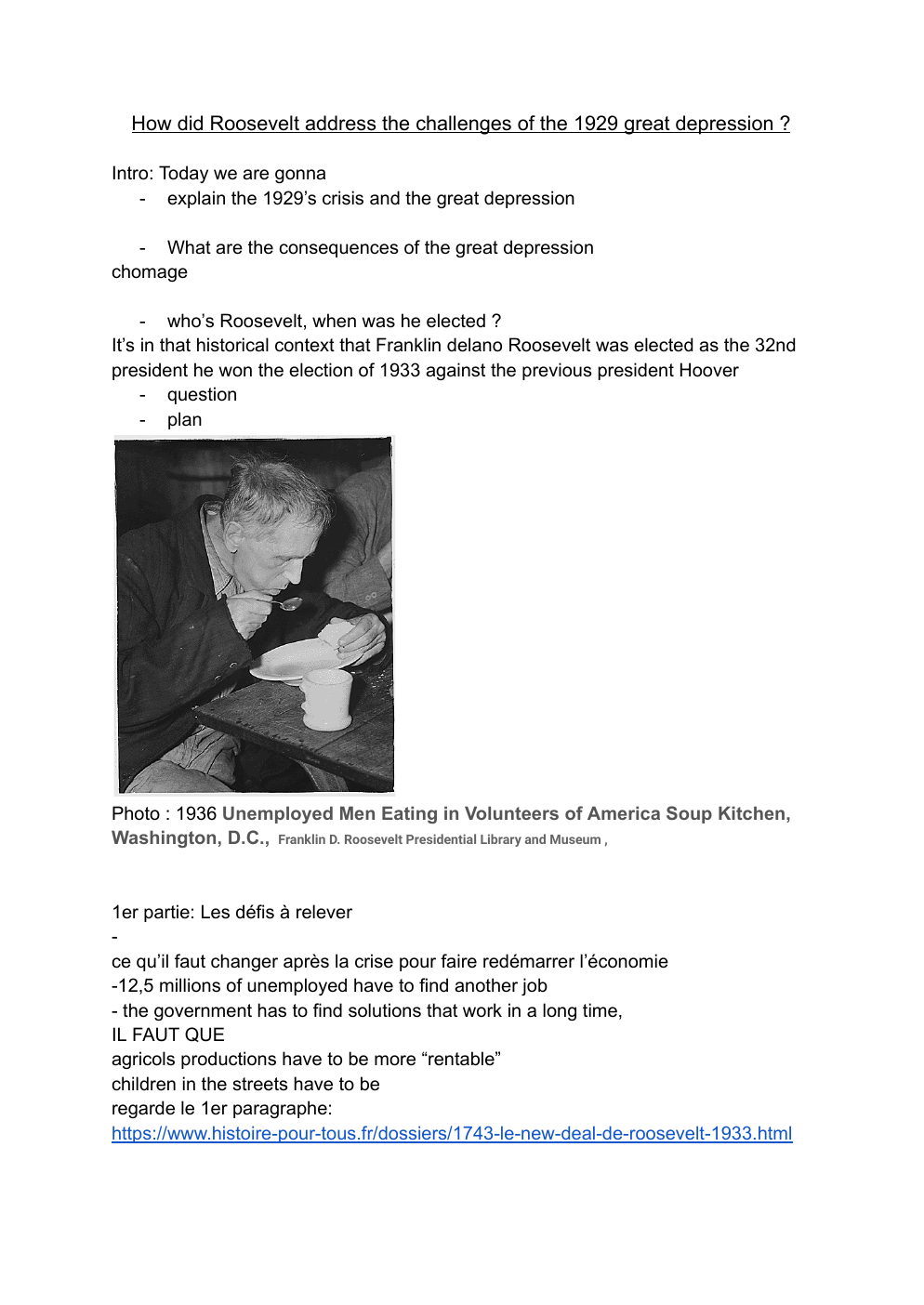How did roosevelt adress the challenges of the 1929 great depression?
Publié le 11/05/2024
Extrait du document
«
How did Roosevelt address the challenges of the 1929 great depression ?
Intro: Today we are gonna
- explain the 1929’s crisis and the great depression
- What are the consequences of the great depression
chomage
- who’s Roosevelt, when was he elected ?
It’s in that historical context that Franklin delano Roosevelt was elected as the 32nd
president he won the election of 1933 against the previous president Hoover
- question
- plan
Photo : 1936 Unemployed Men Eating in Volunteers of America Soup Kitchen,
Washington, D.C., Franklin D.
Roosevelt Presidential Library and Museum ,
1er partie: Les défis à relever
ce qu’il faut changer après la crise pour faire redémarrer l’économie
-12,5 millions of unemployed have to find another job
- the government has to find solutions that work in a long time,
IL FAUT QUE
agricols productions have to be more “rentable”
children in the streets have to be
regarde le 1er paragraphe:
https://www.histoire-pour-tous.fr/dossiers/1743-le-new-deal-de-roosevelt-1933.html
1e part : what are the challenges that roosevelt have to take after the 1929’s crisis?
After the krash, Herbert Hoover, president between 1929 and 1933 in USA, had to
react without training to this huge crisis which had a lot of consequences over the
country and the world.
He didn’t very well took in charges the country, he tried to
find solutions like increase the taxes, but they didn’t work on a long term.
Indeed the economic situation of America was a disaster and it became a real
challenge to help the country to deal with all the consequences of this event.
Like
Ines said, around 25% of the pop loose their job and one part of the objective of
roosevelt, the president who succeeded to hoover in 1933, was to improve the
situation of the unemployment.
His second objective was to do it for a long time to
avoid others crisis in the future.
Moreover, the gross domestic product, which decreased, had to be saved.
All
the economy of the country was in danger.
A lot of demonstrations happened in the
streets, the population shows it’s anger and hunger because it didn't have enough
money to eat.
For example we can see on this picture of 1936 a poor man eating a
soup made for unemployed men.
The government had to find solutions quickly to
feed everyone.
Kids are in the street, without school, because teachers can't be paid so we
have to take care of them to avoid juvenile delinquency.
Industrial production was also really impacted and Roosvelt had to put it in
the same way as before the crisis, (because it fell by half in a really short
time… )
2e partie : Roosevelt and his New Deal policy
To address these challenges, Roosevelt set up his New Deal policy.
Indeed, he
established a proactive and interventionist policy where the government regulated
the economy which is the opposite of the liberal system predominant in America until
then.
It involved the bank's supervision to restore confidence in them or the 60
percent devaluation of the dollar.
Moreover, to reduce unemployment, the president created many administrations like
the WPA and the PWA ( in other words the Works Progress Administration and the
Public Works Administration) that employed millions of jobseekers (mostly men who
were not formally educated) to carry out public works projects including the
construction of public buildings and roads.
Not everyone agreed with his policy
particularly those who defend a liberal economy as this cartoon proves.
It was drawn
by Vaughn Shoemaker in 1935 and it parodies the new deal as a card game with
alphabetical agencies.
Roosevelt also relaunched agriculture by settling prices threshold for agricultural
products and by voting the Agricultural Adjustment Act, to give back value to the
farmers’ crops.
In addition, to make America a welfare state, the president reduced the work time to
35 or 40 hours per week, he increased the salaries and established social security.
And finally the government did a lot of propaganda to remobilize the american
people as we can see on the poster which was promoting the subsidies given to
farmers.
3e partie : The results of this policy
The New Deal helped the financial situation of the Americans and boosted the
businesses all over the country, bringing many new things to the country including
the construction of different buildings.
These are still up nowadays and changed the
landscape of the USA.
(pour bien parler de la photo) This photo comes from the
Public Works Administration Project showing The US Army Corps of Engineers
constructing the city of Bonneville Dam in the state of Oregon.
This is a huge project
which made a lot of people work again.
Making the Americans work again led to a
drop in unemployment which enabled the economy to recover from the very
important crisis.
(pour inclure des chiffres à l’aide du graphique ) In....
»
↓↓↓ APERÇU DU DOCUMENT ↓↓↓
Liens utiles
- How did Roosevelt address the challenges of the Great Depression ?
- the handmaid's tale: How far do you agree that Margaret Atwood makes resistance central to THT?
- How do the three documents interact to deal with the intersection of multiple identities?
- What are the influences of the Gilead society and how they have an impact on the woman’s lives?
- Education in Great Britain? Education is compulsory from the age of 5 (4 in Northern Ireland) to theage of 16.


